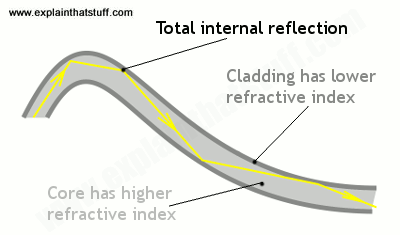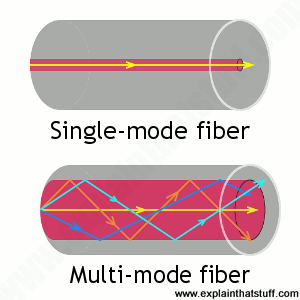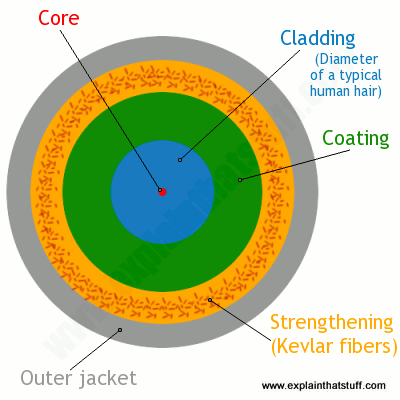How does fiber optics work?


Advertisement
Mục Lục
Optical technology
A fiber-optic cable is made up of incredibly thin strands
of glass or plastic known as optical fibers; one cable can have as few as two
strands or as many as several hundred. Each strand is less than a
tenth as thick as a human hair and can carry something like 25,000 telephone calls,
so an entire fiber-optic cable can easily carry several million calls.
The current record for a “single-mode” fiber (that’s explained below) is
178 terabits (trillion bits) per second—enough for 100 million Zoom sessions
(according to fiber expert Jeff Hecht)!
Fiber-optic cables carry information between two places using
entirely optical (light-based) technology. Suppose you wanted to send
information from your computer to
a friend’s house down the street
using fiber optics. You could hook your computer up to a laser, which
would convert electrical information from the computer into a series of
light pulses. Then you’d fire the laser down the fiber-optic cable.
After traveling down the cable, the light beams would emerge at the
other end. Your friend would need a photoelectric cell (light-detecting
component) to turn the pulses of light back into electrical information
his or her computer could understand. So the whole apparatus would be
like a really neat, hi-tech version of the kind of telephone you can
make out of two baked-bean cans and a length of string!

Photo: A section of 144-strand fiber-optic cable. Each strand is made of optically pure glass and is thinner than a human hair. Picture by Tech. Sgt. Brian Davidson, courtesy of
US Air Force.
How fiber-optics works
Light travels down a fiber-optic cable by
bouncing repeatedly off the walls. Each tiny photon (particle of light)
bounces down the pipe like a bobsleigh going down an ice run. Now you
might expect a beam of light,
traveling in a clear glass pipe, simply to leak out of the edges. But
if light hits glass at a really shallow angle (less than 42 degrees), it
reflects back in again—as though the glass were really a mirror. This
phenomenon is called total internal reflection.
It’s one of the things that keeps light inside the pipe.

Photo: Fiber-optic cables are thin enough to bend, taking the light signals inside in curved paths too. Picture courtesy of NASA Glenn Research Center (NASA-GRC) and
Internet Archive.
The other thing that keeps light in the pipe is the structure of the
cable, which is made up of two separate parts. The main part of the
cable—in the middle—is called the core and that’s the bit
the light travels through. Wrapped around the outside of the core is another
layer of glass called the cladding. The cladding’s job is to keep the
light signals inside the core. It can do this because it is made of a
different type of glass to the core. (More technically, the cladding
has a lower refractive index.)

Artwork: Total internal reflection keeps light rays bouncing down the inside of a fiber-optic cable.
Types of fiber-optic cables
Optical fibers carry light signals down them in what are called modes.
That sounds technical but it just means different ways of traveling:
a mode is simply the path that a light beam follows down the fiber. One mode is
to go straight down the middle of the fiber. Another is to
bounce down the fiber at a shallow angle. Other modes involve bouncing
down the fiber at other angles, more or less steep.

Artworks: Above: Light travels in different ways in single-mode and multi-mode fibers. Below: Inside a typical single-mode fiber cable (not drawn to scale). The thin core is surrounded by cladding roughly ten times bigger in diameter, a plastic outer coating (about twice the diameter of the cladding), some strengthening fibers made of a tough material such as Kevlar®, with a protective outer jacket on the outside.

The simplest type of optical fiber is called single-mode.
It has a very thin core about 5-10 microns (millionths of
a meter) in diameter. In a single-mode fiber, all signals travel
straight down the middle without bouncing off the edges (yellow line in
diagram). Cable TV,
Internet, and telephone signals are generally carried by single-mode
fibers, wrapped together into a huge bundle. Cables like this can send
information over 100 km (60 miles).
Another type of fiber-optic cable
is called multi-mode. Each optical fiber in
a multi-mode cable is about
10 times
bigger than one in a single-mode cable.
This means light beams can travel through the core by following a
variety of
different paths (yellow, orange, blue, and cyan lines)—in other words, in
multiple different modes.
Multi-mode cables can send information only
over relatively short distances and are used (among other things) to
link computer networks together.
Even thicker fibers are used in a medical tool called a gastroscope
(a type of endoscope),
which doctors poke down someone’s throat for detecting illnesses inside
their stomach. A gastroscope is a thick fiber-optic cable consisting
of many optical fibers. At the top end of a gastroscope, there is an
eyepiece and a
lamp. The lamp shines its light down one part of the cable into the
patient’s stomach. When the light reaches the stomach, it reflects off
the stomach walls into a lens
at the bottom of the cable. Then it travels back up another part of the
cable into the doctor’s eyepiece. Other types of endoscopes work the same
way and can be used to inspect different parts of the body. There is also an
industrial version of the tool, called a fiberscope, which can be used
to examine things like inaccessible pieces of machinery in airplane
engines.
Try this fiber-optic experiment!
This nice little experiment is a modern-day recreation of a famous
scientific demonstration carried out by Irish physicist John Tyndall in 1870.
It’s best to do it in a darkened bathroom or
kitchen at the sink or washbasin. You’ll need an old clear, plastic drinks bottle, the brightest flashlight (torch)
you can find, some aluminum foil, and some sticky tape.
- Take the plastic bottle and wrap aluminum foil tightly around the sides,
leaving the top and bottom of the bottle uncovered. If you need to,
hold the foil in place with sticky tape. - Fill the bottle with water.
- Switch on the flashlight and press it against the base of the
bottle so the light shines up inside the water. It works best if you
press the flashlight tightly against the bottle. You need as much light
to enter the bottle as possible, so use the brightest flashlight you can
find. - Standing by the sink, tilt the bottle so the water starts to pour
out. Keep the flashlight pressed tight against the bottle. If the room
is darkened, you should see the spout of water lighting up ever so
slightly. Notice how the water carries the light, with the light beam
bending as it goes! If you can’t see much light in the water spout, try a brighter flashlight.

Photo: Seen from below, your water bottle should look like this when it’s
wrapped in aluminum foil. The foil stops light leaking out from the sides of the bottle.
Don’t cover the bottom of the bottle or light won’t be able to get in.
The black object on the right is my flashlight, just before I pressed
it against the bottle. You can already see some of its light shining into the bottom of the
bottle.
Please do NOT copy our articles onto blogs and other websites
Articles from this website are registered at the US Copyright Office. Copying or otherwise using registered works without permission, removing this or other copyright notices, and/or infringing related rights could make you liable to severe civil or criminal penalties.
Text copyright © Chris Woodford 2006, 2020. All rights reserved. Full copyright notice and terms of use.
Follow us
Rate this page
Please rate or give feedback on this page and I will make a donation to WaterAid.
Save or share this page
Press CTRL + D to bookmark this page for later or tell your friends about it with:
Cite this page
Woodford, Chris. (2006/2020) Fiber optics. Retrieved from https://www.explainthatstuff.com/fiberoptics.html. [Accessed (Insert date here)]















![Toni Kroos là ai? [ sự thật về tiểu sử đầy đủ Toni Kroos ]](https://evbn.org/wp-content/uploads/New-Project-6635-1671934592.jpg)


